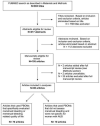Abnormal uterine bleeding: a review of patient-based outcome measures
- PMID: 18635169
- PMCID: PMC2746391
- DOI: 10.1016/j.fertnstert.2008.04.023
Abnormal uterine bleeding: a review of patient-based outcome measures
Abstract
Objective: To summarize and evaluate the patient-based outcome measures (PBOMs) that have been used to study women with abnormal uterine bleeding (AUB).
Design: Systematic review.
Setting: Original articles that used at least one PBOM and were conducted within a population of women with AUB.
Patient(s): Women with AUB.
Intervention(s): The titles, abstracts, and studies were systematically reviewed for eligibility. The PBOMs used in eligible studies were summarized. Essential psychometric properties were identified, and a list of criteria for each property was generated.
Main outcome measure(s): "Quality" of individual PBOMs as determined using the listed criteria for psychometric properties.
Result(s): Nine hundred eighty-three studies referenced AUB and patient-reported outcomes. Of these, 80 studies met the eligibility criteria. Fifty different instruments were used to evaluate amount of bleeding, bleeding-related symptoms, or menstrual bleeding-specific quality of life. The quality of each of these instruments was evaluated on eight psychometric properties. The majority of instruments had no documentation of reliability, precision, or feasibility. There was no satisfactory evidence that any one instrument completely addressed all eight psychometric properties.
Conclusion(s): Studies of women with AUB are increasingly using PBOMs. Many different PBOMs were used; however, no single instrument completely addressed eight important measurement properties.
Figures
References
-
- Barnard K, Frayne SM, Skinner KM, Sullivan LM. Health status among women with menstrual symptoms. J Womens Health. 2003;12:911–9. - PubMed
-
- MORI Women's Health in 1990. Market Opinion and Research International (Research study conducted on behalf of Parke-Davis Laboratories) 1990
-
- Cote I, Jacobs P, Cumming D. Work loss associated with increased menstrual loss in the United States. Obstet Gynecol. 2002;100:683–7. - PubMed
-
- Cote I, Jacobs P, Cumming DC. Use of health services associated with increased menstrual loss in the United States. Am J of Obstet Gynecol. 2003;188:343–8. - PubMed
Publication types
MeSH terms
Grants and funding
LinkOut - more resources
Full Text Sources
Medical
Miscellaneous


